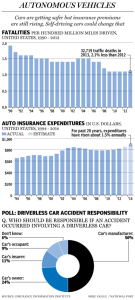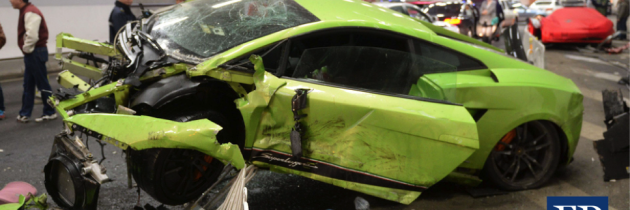The coming age of self-driving cars: What will auto insurers do when there are no drivers left to insure?
This article originally posted at business financial post
A driver speeds around a dark curve in the road. He doesn’t realize that just around the bend ambles a slow-moving, enormous tractor-trailer. The way the sedan careens around the blind curve, it seems that the worst outcome is unavoidable: a head-on collision. Very likely fatal. But then, suddenly, it doesn’t happen.
Crucial seconds before the car finishes the turn, the vehicle’s adaptive headlights have turned on their own to spotlight the truck. The car senses the problem with its forward-collision warning system and sends a warning to the driver, as it prepares to automatically activate the car’s brakes to stop short of the truck’s path.
These accident-prevention systems, already in place in many new vehicles today, are already drastically reducing the likelihood of dangerous car wrecks. The number of fatal collisions on Canadian roads is already nearly 40 per cent lower than it was just 25 years ago, but just between 2012 and 2013 (the latest Transport Canada figures available) they had dropped a remarkable 7.3 per cent, and injuries fell by almost precisely the same amount. These were the lowest recorded auto-fatality rates ever.
Of course, in the two years since then, carmakers have been developing yet more safety features. And in the not-too-distant future, an entirely self-driving car — of the sort being aggressively developed by Google and Ford — may be able to recognize the risk long before the driver even approaches that curve, slowing the car down and adjusting for the turn, even as the truck’s own self-driving systems are activating their own avoidance measures. It’s conceivable that sometime in our lives, the possibility of an accident like this happening could be virtually eliminated.
* * *
Champions of the coming age of autonomous vehicles envision a time when car accidents do indeed become a regrettable horror of the past, in the same league as smallpox and bloodletting. It’s easy to embrace that utopian optimism. But for all the incredible benefits an era like that co uld bring, there’s one industry that may not be looking forward to its arrival: auto insurers.
uld bring, there’s one industry that may not be looking forward to its arrival: auto insurers.
Insuring autos is a massive industry — Canadian auto insurers wrote $21.4 billion in new premiums last year. But a growing body of analysis is questioning what will happen as cars become increasing
ly automated, perhaps one day eliminating the need for drivers to be insured at all.
The technology, said analyst Meyer Shields, has the potential to no less than “eviscerate” the auto-insurance business.
“If there’s much less risk involved in owning a car, then there’s just less need for insurance,” said Shields, who works at the New York investment bank Keefe, Bruyette & Woods, which specializes in the financial services business.
And U.S. research firm Celent predicted in 2012 that, due to the rapid decline in claims, American auto liability premiums will decline by 20 per cent from 2013 to 2017 and then plummet another 60 per cent from 2018 to 2022 as safety technologies become increasingly advanced. Physical damage premiums will drop even more dramatically under the same scenario, by 30 per cent and 80 per cent respectively.
Read the full article on business financial post





Peoples minds ain’t open enough to like this